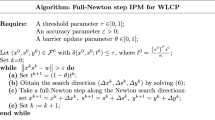Abstract
In this paper, we present an (m+1)-step iterative method of convergence order (m+2) for solving linear complementarity problems. The proposed iterative method is simple and easy to construct, and requiring only third Fréchet differentiation. Computational efficiency in its general form is discussed and a comparison between the efficiency of the proposed method and existing ones is made. The performance is tested through numerical experiments on some test problems.
Similar content being viewed by others
References
Cottle, R.W.: The principal pivoting method of quadratic programming. In: Dantzig, G.B., Veinott, A.F. (eds.) Mathematics of Decision Sciences, Part 1, pp. 142–162. AMS, Providence, RI (1968)
Chung, S.J.: NP-completeness of the linear complementarity problem. J. Optim. Theory Appl. 60, 393–399 (1989)
Cottle, R.W., Pang, J.S., Stone, R.E.: The linear complementarity problem. Academic Press, Boston (1992)
Murty, K.G.: Linear Complementarity, Linear and Nonlinear Programming, Internet Ed. North-Holland Publishing Co., Amsterdam (1997)
Lemke, C.E.: Bimatrix equilibrium points and mathematical programming. Manag. Sci. 11, 681–689 (1965)
Scarf, H.: The approximation of fixed points of a continuous mapping. SIAM J. Appl. Math. 15, 1328–1342 (1967)
Eaves, B.C., Scarf, H.: The solution of systems of piecewise linear equations. Math. Oper. Res. 1, 1–27 (1976)
Eaves, B.C., Lemke, C.E.: Equivalence of LCP and PLS. Math. Oper. Res. 6, 475–484 (1981)
Cottle, R.W., Dantzig, G.B.: A life in mathematical programming. Math. Program. 105, 1–8 (2006)
EL Foutayeni, Y., Khaladi, M.: A new interior point method for linear complementarity problem. Appl. Math. Sci. 4, 3289–3306 (2010)
EL Foutayeni, Y., Khaladi, M.: Using vector divisions in solving the linear complementarity problem. J. Comput. Appl. Math. 236, 1919–1925 (2012)
EL Foutayeni, Y., Khaladi, M.: General characterization of a linear complementarity problem. Am. J. Model. Optim. 1, 1–5 (2013)
EL Foutayeni, Y., Khaladi, M.: A Min-Max algorithm for solving the linear complementarity problem. J. Math. Sci. Appl. 1, 6–11 (2013)
EL Foutayeni, Y., EL Bouanani, H., Khaladi, M.: The linear complementarity problem and a method to find all its solutions. Inf. Sci. Comput. 3, 1–5 (2014)
Samelson, H., Thrall, R.M., Wesler, O.: A partition theorem for Euclidean n-space. Proc. Am. Math. Soc. 9, 805–807 (1958)
Stoer, J., Bulirsch, R.: Introduction to Numerical Analysis. Springer, Berlin (1983)
Traub, J.F.: Iterative Methods for the Solution of Equations. Prentice-Hall, New Jersey (1964)
Geiger, C., Kanzow, C.: On the resolution of monotone complementarity problems. Comput. Optim. Appl. 5, 155–173 (1996)
Mathiesen, L.: An algorithm based on a sequence of a linear complementarity problems applied to a Walrasion equilibrium model: an example. Math. Program. 37, 1–18 (1987)
Pang, J.S., Gabriel, A.: NE/SQP: a robust algorithm for nonlinear complementarity problems. Math. Program. 60, 295–337 (1993)
Yu, Z., Qin, Y.: A cosh-based smoothing Newton method for \(\text{ P }_{0}\) nonlinear complementarity problem. Nonlinear Anal.: Real World Appl. 12, 875–884 (2011)
Kanzow, C.: Some noninterior continuation methods for linear complementarity problems. SIAM J. Matrix Anal. Appl. 17, 851–868 (1996)
Chen, B., Harker, P.T.: A noninterior-point continuation method for linear complementarity problems. SIAM J. Matrix Anal. Appl. 14, 1168–1190 (1993)
Smale, S.: Algorithms for solving equations. In: Gleason, A.M. (ed.) Proceeding of the International Congress of Mathematicians, pp. 172–195. American Mathematics Society, Providence, Rhode Island (1987)
Acknowledgments
The authors are sincerely grateful to the anonymous referees and the Corresponding Editor for their valuable comments, which lead to a substantial improvement in the contents of this paper.
Author information
Authors and Affiliations
Corresponding author
Appendix
Appendix
A. MATLAB program for functions \(F_{k}\), \(F_{k}^{\prime }\), and for solving \(F_{k}(x)=0\)

B. MATLAB program for Example 1

C. MATLAB program for Example 2

Rights and permissions
About this article
Cite this article
EL Foutayeni, Y., EL Bouanani, H. & Khaladi, M. An (m+1)-step iterative method of convergence order (m+2) for linear complementarity problems. J. Appl. Math. Comput. 54, 229–242 (2017). https://doi.org/10.1007/s12190-016-1006-y
Received:
Published:
Issue Date:
DOI: https://doi.org/10.1007/s12190-016-1006-y
Keywords
- Linear complementarity problem
- (m+1)-Step iterative method
- (m+2) Order method
- Sequence of smooth functions
- System of non-linear equations



